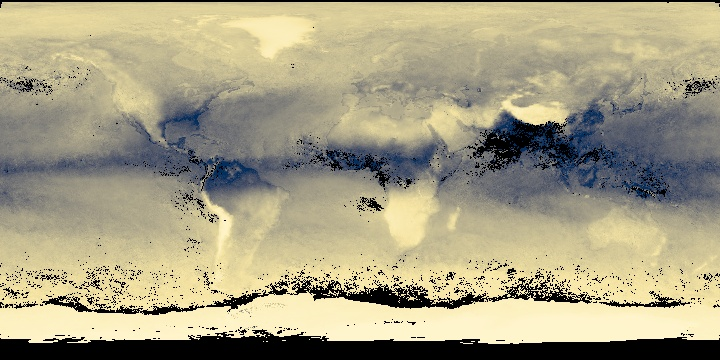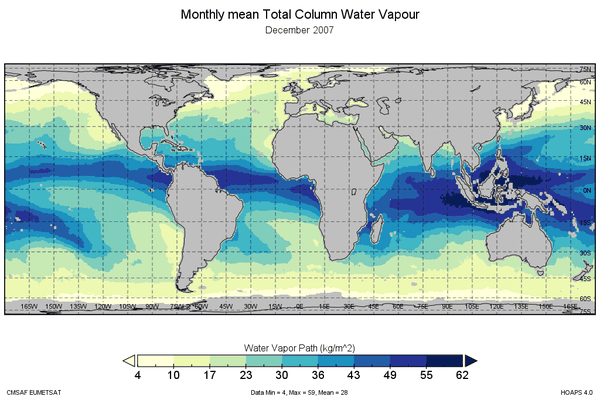
Is water vapor properly taken into account when calculating the greenhouse effect?
The use of fossil fuels (oil, coal, natural gas) leads not only to CO2 emissions, but also to water vapor. So it’s natural to wonder why we hardly talk about the impact of human emissions of water vapor.
In fact, the concentration of water vapor in the atmosphere is essentially controlled by its temperature. If we try to put more water vapour into the atmosphere, it is rapidly eliminated by precipitation. The average residence time of a water molecule in the atmosphere is around 10 days.
As a result, atmospheric water vapour concentration is controlled by very rapid, natural processes, and direct emissions of water vapour by human activities have very little influence. The carbon cycle operates in a very different way to the water cycle, which is why the concentration of CO2 in the atmosphere is rising rapidly as a result of human activity.

Aqua/MODIS and Terra/MODIS Temperature and Water Vapor Profiles 5-Min L2 Swath 5km data are available from the Level-1 and Atmosphere Archive & Distribution System Distributed Active Archive Center (LAADS DAAC)
The greenhouse effect is generated by the absorption of infrared radiation by a number of atmospheric molecules. First of all, two-atom molecules such as oxygen (O2) and nitrogen (N2), which make up 99% of the atmosphere, absorb virtually no infrared radiation and therefore make no contribution to the greenhouse effect.
Conversely, other molecules, in particular water vapor (H2O), carbon dioxide (CO2), nitrous oxide (N2O) and methane (CH4), absorb and emit infrared radiation. These molecules therefore contribute to the greenhouse effect.
This absorption/emission of infrared radiation in the atmosphere is well understood. In the laboratory, we can measure the absorption intensity of various gases as a function of temperature and pressure. There are models that calculate the propagation of infrared radiation in the atmosphere, and these models are in almost perfect agreement with the measurements.
In fact, they are used every day to estimate vertical temperature and vapor profiles in the atmosphere, based on satellite radiation measurements. Absorption by water vapor, carbon dioxide or other gases is therefore perfectly known and quantified.
Water vapor is the third most abundant gas in the atmosphere and the leading greenhouse gas. This is clearly demonstrated by the measurements and radiative transfer models mentioned above. However, these same models show that the contribution of carbon dioxide is far from negligible, despite its lower concentration.
This is because CO2 absorbs infrared radiation at wavelengths different from those of water vapor. Moreover, the concentration of water vapour in the atmosphere is highly variable, decreasing rapidly with altitude. At higher altitudes, CO2 absorption dominates, modifying the planet’s radiation balance.
Contrary to what is sometimes claimed, the greenhouse effect is not saturated and continues to increase as the concentrations of the various gases mentioned above rise.

Water vapor is not the driving force behind global warming, but it does contribute to it through an amplifying effect. Indeed, increasing concentrations of gases such as CO2 and CH4 amplify the greenhouse effect, and thus raise temperatures.
In a warmer atmosphere, there can be more water vapor. Rising temperatures therefore lead to higher concentrations of atmospheric water vapor. Since water vapor absorbs infrared radiation, this reinforces the greenhouse effect, leading to a further rise in temperatures.
This effect is well understood; it is taken into account in climate models, which show that it leads to a significant rise in temperatures over and above what would already be expected without this feedback.
More info:
Depending upon its temperature, water comes in three different forms: solid (ice), liquid (rain drops), and gas (invisible to human eyes). As water grows hotter it eventually changes from a liquid into a gas. This gas is called water vapor. Water vapor is a very important part of Earth’s atmosphere because it traps heat near the surface and keeps our planet warm. Water vapor is also important because as it rises into the atmosphere it cools and turns back into water droplets. As more water droplets appear, they eventually form a cloud. Some clouds produce rain and snow, bringing fresh water back to the surface. So scientists monitor water vapor because it influences Earth’s weather patterns, and because it is a very important part of our world’s climate system. These maps show satellite measurements of water vapor for a given day, or over a span of days.
https://neo.gsfc.nasa.gov/view.php?datasetId=MYDAL2_M_SKY_WV




